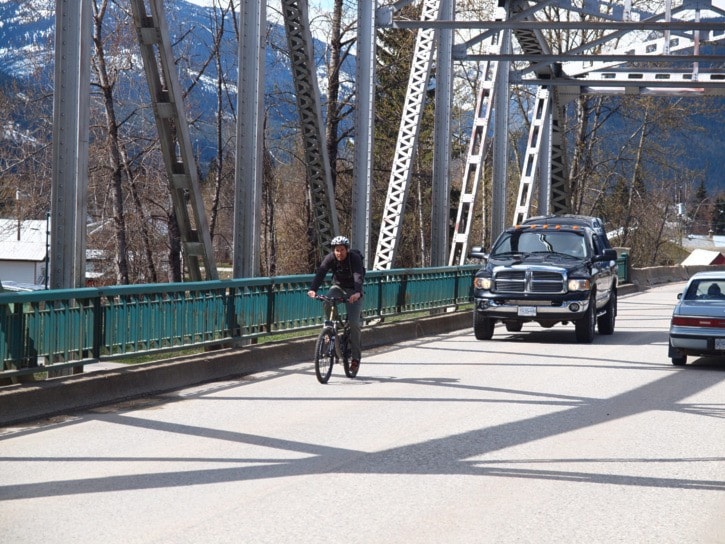Bike To Work Week, By Alex Cooper
Revelstoke Bike to Work Week 2011 takes place from May 30 to June 5. Over the next four weeks, the Times Review will publish four exclusive articles related to bicycle commuting in Revelstoke written by committee member Alex Cooper. This week’s article looks at the biggest problem areas for cyclists in Revelstoke.
A year ago this month, to little fanfare, the City of Revelstoke created its first bike lane. One day, new lines and bicycle lane markers were painted along a 400 metre stretch of Airport Way between the Illecillewaet Bridge and McKinnon Road. It’s not much but it’s a start.
Revelstoke is a very bike friendly city; the streets are wide, it’s mostly flat and there is relatively little traffic. That said, there are still some areas that pose issues for cyclists.
The Illecillewaet Bridge is generally regarded as the biggest problem area for cyclists. The bridge is a choke point between Arrow Heights and the rest of town. On both approaches the road narrows as it rounds a bend – not a very good combination. Some cyclists use the sidewalk to cross the bridge but most stay on the roadway. If a car comes whizzing behind, you just have to hope they either slow down or there’s no one oncoming so they can pass safely.
“People are trying to do the right thing by riding on the travel portion of the highway but the bridge isn’t really that safe for doing that,” said coun. Phil Welock, who sits on the city’s road safety committee. “I walk that [bridge] everyday and I don’t know what we could do.”
Brian Mallett, the city’s director of engineering and public works, said the city is looking at several solutions and will be painting a double solid line on the bridge, meaning cars can’t pass cyclists on the bridge. It will also be made into a no passing zone, he said.
“It’s not a perfect solution but to try to get thing absolutely perfect, we don’t have the cash reserves to do right now,” he said.
Closer to town, where Fourth Street, Townley Street and Victoria Road converge is another problem area. The main issue is with cyclists rounding the bend onto Victoria Road and then trying to turn up onto Third or Second Streets to head into the city centre. With cars speeding around bends from both in front and behind, it makes for a rather hairy crossing.
“That’s an ugly intersection there,” said Mallett. “We still need to make that fairly easy for cyclists to be moving through. You don’t want a family or a bunch of kids riding along Victoria.”
Victoria Road itself is probably the worst street for cycling, even though it’s four lanes along most of its route. At its western end is another hazard – the underpass beneath the CPR tracks. Just before, the four-lane road narrows to two lanes and with cars generally travelling at a high speed, it can make for a scary transition. Fortunately, for people heading to and from Columbia Park, there’s an alternate route a few blocks south along the river trail from the Big Eddy Bridge, through Woodenhead Park and under the highway.
Speaking of the Big Eddy Bridge, that last one is also a tricky spot for cyclists. The limited time to cross the bridge means the roadway really isn’t an option. I tried it once and the lineup of cars building behind me was definitely intimidating. Meanwhile, the sidewalk isn’t really wide enough for cyclists and pedestrian to pass, though, as Mallett notes, “It’s considered a sidewalk so you should really be walking your bike across it.”
Two other areas considered issues are Red Devil Hill, which will be also turned into a double-solid line and Johnson Heights, which involves cycling along the highway for a stretch. Unfortunately, for the latter, Mallett said it didn’t look like there was much to do to improve bike access. “That’s not to rule out that some time in the future there’s not the possibility things will change there,” he said.
Next week the Bike to Work Week Committee will look at what the city has planned for cyclists in the future.
